
OK, let’s be honest here: By no sane barometer of actual merit can Universal’s 1940s “Mummy” movies be called…well, good. That does not, however, keep them from being perfectly viable entertainment of the B-horror kind. That the films are a little — and maybe more than a little — on the silly side is in their favor. That they don’t fit together as a series is part of their charm. It helps to put Universal — known as the house of horror — into perspective. The horror films for which it became known in the 1930s were made by the studio’s original founders, the Laemmle family. These later films came from what was briefly called “New Universal” and which mostly worked on an assembly-line basis. The actual relation to those earlier films is often tenuous and never of the same quality. The first of this second incarnation of Universal’s “Mummy” films reconfigured Karl Freund’s poetic The Mummy (1932) into a slick B-picture, The Mummy’s Hand (1940). It was popular and the studio was in the market for something to shunt their newest horror star, Lon Chaney, Jr., into anything that could turn a buck; so Chaney found himself in this series. At their best, these films are known for surprisingly atmospheric production values. At their worst…well, we’ll leave that.
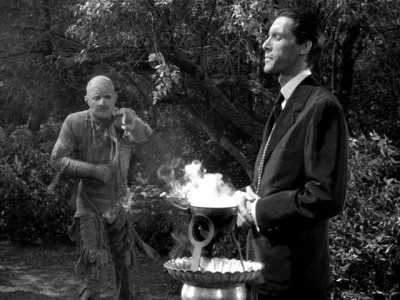
Unable to compete with the bigger studios — except on rare occasions — Universal decided to pitch their major product to what they determined was their core audience. That audience, they concluded, mostly consisted of kids, teenagers, the lower classes and certain ethnic groups — and they took a very dim view of what they perceived to be the intellectual capacity of that audience. As a result, things like narrative coherence were considered just so much frippery, while any thought that the films were meant to hook together was never even on the radar. So what if The Mummy’s Tomb (1942) had ended with old Kharis (Chaney) perishing in a burning house? He emerges — none the worse for wear — just wandering around the New England countryside at the beginning of The Mummy’s Ghost (1944) when a college professor (reliable old Frank Reicher) ill-advisedly brews up some tana leaves and brings the mummy a-running — well, doing a real slow drag anyway. Where he’s been all this time and how he’d remained ambulatory without his requisite dose of tana fluid is not addressed.
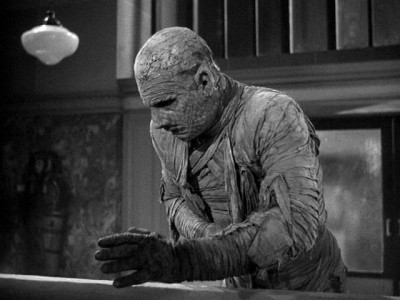
In fairness, it never occurred to anyone that these movies would hang around. Universal thought so little of this stuff that they were happy to license them to Realart Pictures for re-release in the late 1940s, and rather than see any TV value in them in the late 1950s, they simply licensed them to Screen Gems. In 1944, the idea that nearly 70 years later people would be collecting the damned things on little silver discs to watch at home — or that anyone would even remember they even existed — would have drawn blank stares from the folks who made them. But here we are still watching them — and if we’re enjoying them on a slightly different level than was intended, does it really matter? In terms of entertainment, I’d say, no, it doesn’t. And really, everybody except maybe the writers deserves high marks for these things being as good as they are.
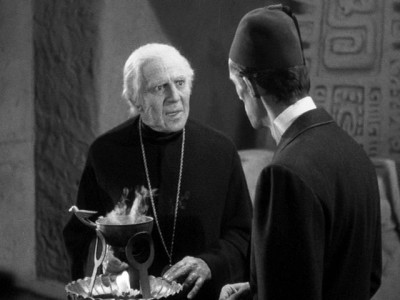
The Mummy’s Ghost tends to be viewed as one of the better entries — probably because it has an unusually downbeat ending for an unassuming B-picture and takes itself fairly seriously. This doesn’t mean it isn’t still a thing of shreds and patches. Through the magic of stock footage, for example, we see George Zucco climb the stone steps (left over from James Whale’s Green Hell) to the temple only to emerge inside this holy of holies as John Carradine who meets up with…George Zucco. This verges on the surreal — and for anyone familiar with the movies that came before it, it only gets weirder. It isn’t enough that we saw Wally Ford pump old George full of lead at the end of The Mummy’s Hand. We also saw him expire of old age in another film and later becomes inexplicably better in The Mummy’s Tomb. Well, now he’s back — with a bad case of the shakes and some dodgy old-age makeup — assigning the task of bringing Kharis and the Princess Ananka back from America to John Carradine. Now, whether Carradine proves himself to be just as duplicitous and horny as Zucco had turned out to be in his day remains to be seen. Given the series’ basic lack of originality, it’s not hard to guess, though.
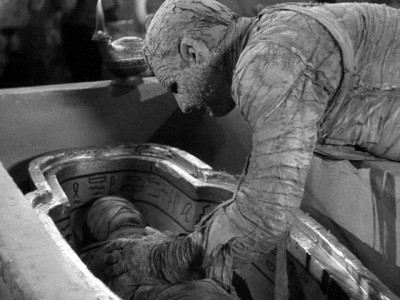
What’s surprising about The Mummy’s Ghost is how very good individual scenes are in terms of atmosphere — especially when propped up by reworkings of Frank Skinner’s score for Son of Frankenstein. Most of Kharis’ nocturnal forays are decidedly creepy — despite the fact that we’re dealing with a monster who requires his victim to back himself into a corner or be too paralyzed with fear to run. (Let’s face it, Kharis is not fleet of foot.) It’s also the film that gives Kharis the most to do, which in one memorable instance shows us the interesting spectacle of a mummy temper tantrum looks like. It’s actually kind of hard to blame the old fellow. There she is — Ananka — right within his grasp and what happens? Her bandages collapse into a dusty heap, leaving him reaching for nothing after all this trouble. My guess is you’d be pissed off, too.
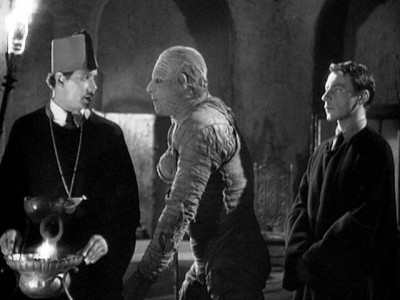
Less serious and altogether less effective is the final film in the Kharis saga,The Mummy’s Curse (1944). Oh, it has its compensations — not entirely of the serious kind. The entire setup here is puzzling to say the least. When last we saw Kharis, he was wandering into a swamp in New England with his Princess Ananka. Somehow — perhaps the most extreme version of continental drift known to science — this time he and Ananka are in the Louisiana bayous, which are being drained. Naturally, this means they’re going to be on the loose again. None of it makes a lick of sense, but it affords the film a different “son of a gun, gonna have big time on the bayou” set of supporting characters, including Ann Codee as the immortal Cajun songstress, Tante Berthe. Just why and how there’s a disused stone monastery on top of a mountain in the swamps is wisely left unexplored, but the film dearly loves to place characters at the foot of the matte painting depicting said edifice. (Well, it’s the coolest looking thing in the movie.)
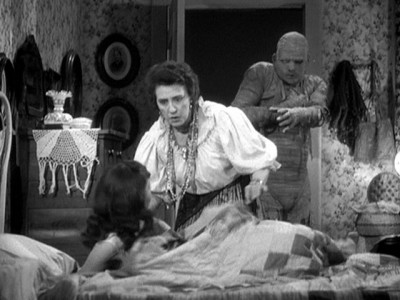
For some reason, Kharis emerges from the bog as his old self, but Ananka — last seen as a rapidly aging Ramsay Ames — appears here as Virginia Christine (to persons of my generation best known as Mrs. Olsen in a series of Folger’s Coffee commercials where she saved marriages by recommending the superior beverage), who turns up fresh as a daisy once the old-age makeup washes off in a lake. It’s all on the silly side and is often more amusing than terrifying. There’s a terrific sequence where Kharis has three near misses with supremely unaware victims who keep moving out of the way just in time. We might also note the presence of black character actor Napoleon Simpson as the appallingly stereotypical Goobie (he calls every white man “massa”), who enlivens the proceedings by saying things like, “The mummy’s on the loose and he’s dancin’ with the devil.” What that actually means is anybody’s guess, but it sounds swell.
The Thursday Horror Picture Show will screen The Mummy’s Ghost and The Mummy’s Curse Thursday, Feb. 14 at 8 p.m. in the Cinema Lounge of The Carolina Asheville and will be hosted by Xpress movie critics Ken Hanke and Justin Souther.



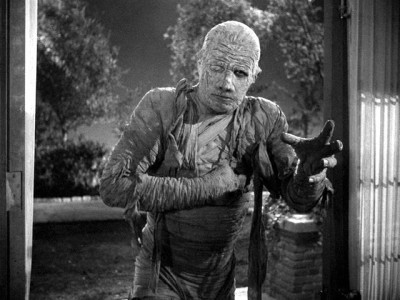
Before you comment
The comments section is here to provide a platform for civil dialogue on the issues we face together as a local community. Xpress is committed to offering this platform for all voices, but when the tone of the discussion gets nasty or strays off topic, we believe many people choose not to participate. Xpress editors are determined to moderate comments to ensure a constructive interchange is maintained. All comments judged not to be in keeping with the spirit of civil discourse will be removed and repeat violators will be banned. See here for our terms of service. Thank you for being part of this effort to promote respectful discussion.